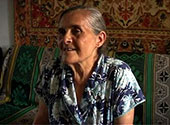
Elizaveta Bershadskaia was born in Chernyatka in 1927. Her father was a barber and was also born in Chernyatka. Her mother was born in Bershad and worked as a seamstress. She had two brothers and a sister. She moved to Bershad at the age of 13, and spent much of the war in the Bershad ghetto. We interviewed her on July 18, 2002 in Bershad.
Other Interviews:
Getting Ready For SabbathHow to Get Food
Liberation
Our House
Mama's Mamaliga
Jewish Professions
Bershad, Ukraine
Handicrafts with the very essence of Jewish professional life in the shtetl. The Jewish concentration in traditional crafts drew a sharp distinction between the Christian peasants who lived in the countryside and the Jews who lived in the urban centers. In this sense, the shtetl was often defined as the place where Jews lived; and Jewish men, in turn, were equated with artisans. This impression of two starkly demographically distinct regions is supported by census data. According to the 1926 census, only 11 percent of all Ukrainians—Jews and non-Jews—lived in urban centers. However, 91.4 percent of Ukrainian Jews were urban. Ukraine had significant Jewish populations, informing the identity of the cities and their relationships with surrounding satellite shtetls.
Elizaveta Bershadskaia was among the few Jews born in the rural villages around Bershad. She was born in the village of Chernyatka, 30 kilometers across the Southern Bug River, in 1927. Her father, Kalmen, was a barber, and her mother, Khave, a seamstress. Elizaveta, too, recalled how few Jews lived outside the town. In this clip, she explains that her father’s clients were predominantly non-Jews. Even in the village, Jews tended not to engage in agrarian work, but rather worked as artisans. She is proud that even the Gentiles recognized the skills the Jews could bring to the rural villages.
